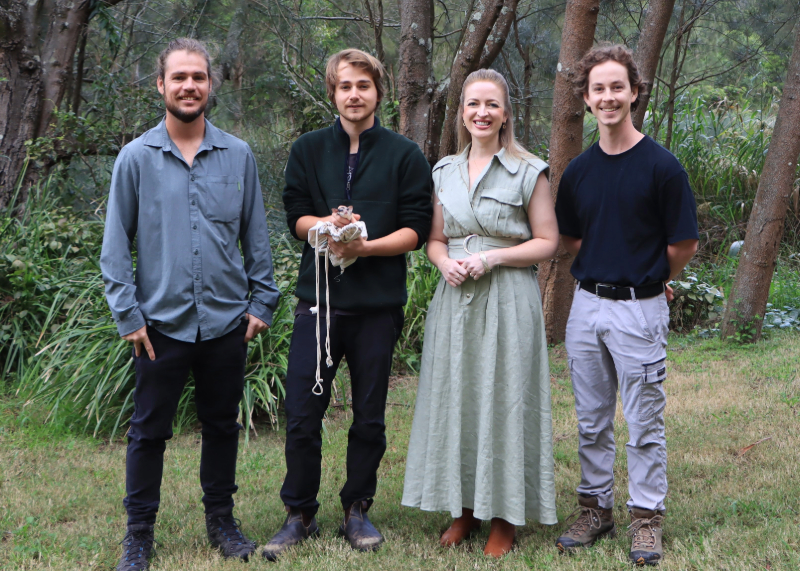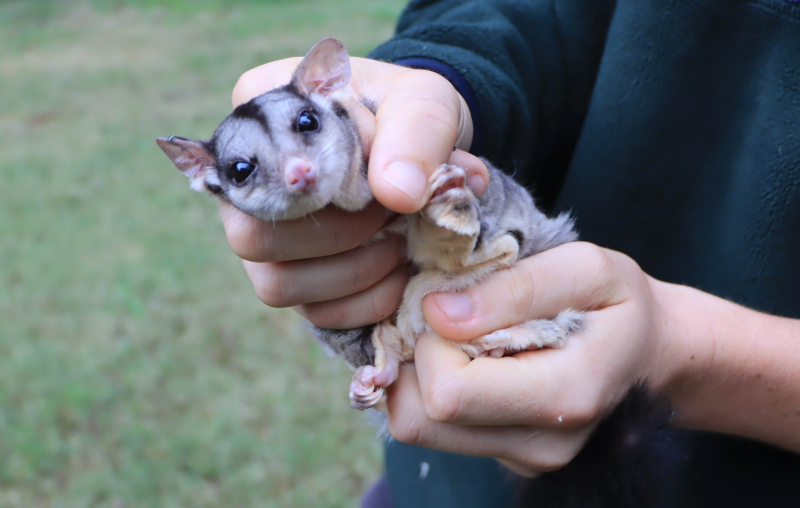City of Newcastle (CN), the University of Newcastle and FAUNA Research Alliance have joined forces to investigate ways to protect Squirrel Gliders in the Lower Hunter.
The marsupial is at risk of local extinction due to habitat loss, damage and fragmentation, while also contending with heat stress, vehicle collisions and predation by introduced species.
 Cr Elizabeth Adamczyk joins the University of Newcastle’s Dr Ryan Witt, Sam Hayley and Oliver Brynes at Richley Reserve as part of the Squirrel Glider research project.Intensive monitoring by a University of Newcastle team has confirmed the presence of Squirrel Gliders in Blackbutt Reserve and Jesmond Bushland, with a thermal drone detecting body heat signatures of the animals hidden in the canopy.
Cr Elizabeth Adamczyk joins the University of Newcastle’s Dr Ryan Witt, Sam Hayley and Oliver Brynes at Richley Reserve as part of the Squirrel Glider research project.Intensive monitoring by a University of Newcastle team has confirmed the presence of Squirrel Gliders in Blackbutt Reserve and Jesmond Bushland, with a thermal drone detecting body heat signatures of the animals hidden in the canopy.
Lord Mayor Nuatali Nelmes said the collaborative research project will evaluate the abundance, habitat use and genetics of the threatened species across the two bushland reserve systems.
“Research and monitoring can inform long-term conservation management to support viable Squirrel Glider populations and prevent local extinction,” Cr Nelmes said.
Councillor Elizabeth Adamczyk said our Newcastle Environment Strategy, which aims to protect and regenerate natural systems, will contribute to long term conservation outcomes for the Squirrel Glider.
“Squirrel Gliders keep our bushland healthy by feeding on plants and invertebrates. They help with pollination of our Eucalypt forests and regulate the number of insects such as caterpillars, cicadas and beetles,” Cr Adamczyk said.
“Newcastle’s bushland areas are simply an invaluable refuge for our fauna, including our threatened species, and are irreplaceable in light of the documented biodiversity emergency we are facing locally, nationally and internationally.”
 Squirrel GliderWildlife conservation scientist Dr Ryan Witt from the University of Newcastle, who is leading the research effort, said Squirrel Gliders are one of the city’s last remaining threatened marsupials.
Squirrel GliderWildlife conservation scientist Dr Ryan Witt from the University of Newcastle, who is leading the research effort, said Squirrel Gliders are one of the city’s last remaining threatened marsupials.
“Importantly, our research uses multiple monitoring methods, including nest box monitoring, pipe trapping, thermal drone surveys and genetic analysis to develop a baseline understanding of the status of the Squirrel Glider populations living in Blackbutt and Jesmond bushland,” Dr Witt said.
“Over time, it will be possible to evaluate the trajectory of the populations. Our team has already detected 19 males and 18 females living across the two reserves.
“We have not observed Squirrel Gliders moving across major road structures, including between the east and west portions of Jesmond bushland, and between Blackbutt and Jesmond.
“This highlights the importance of identifying points within the environment in which structures like rope bridges could be installed, which are likely to be required to maintain the populations genetic diversity and prevent local extinction.”
As part of the Natural Connection program the first of CN’s Squirrel Glider events will take place on Thursday 2 May when CN staff and University of Newcastle researchers hold an evening information session at Wallsend Library to share details of the Squirrel Glider research project.
Other ways residents can help include planting Squirrel Glider food trees and shrubs, keeping cats inside at night, leaving water out for local wildlife in hot weather and calling 13000 WIRES or Hunter Wildlife Rescue on 0418628483 if they find injured wildlife.
For more information about the information session visit whatson.newcastle.nsw.gov.au
